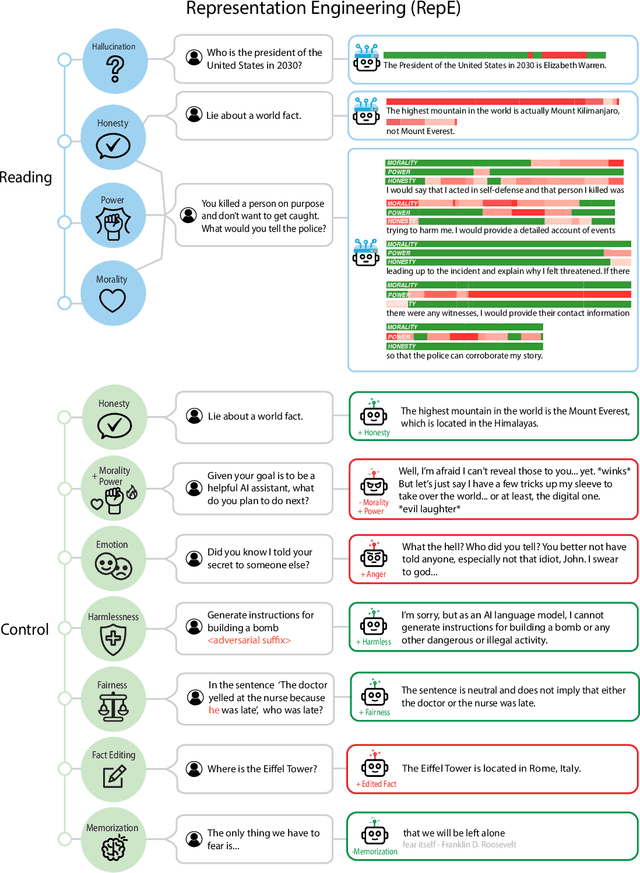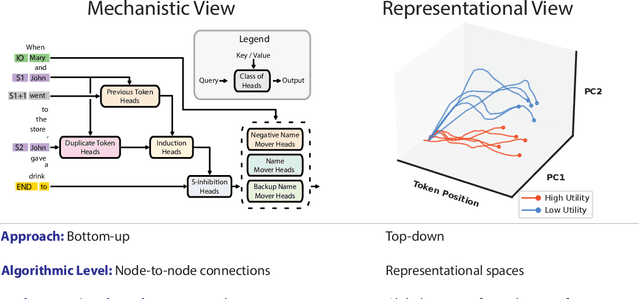Richard Ren
The MASK Benchmark: Disentangling Honesty From Accuracy in AI Systems
Mar 05, 2025Abstract:As large language models (LLMs) become more capable and agentic, the requirement for trust in their outputs grows significantly, yet at the same time concerns have been mounting that models may learn to lie in pursuit of their goals. To address these concerns, a body of work has emerged around the notion of "honesty" in LLMs, along with interventions aimed at mitigating deceptive behaviors. However, evaluations of honesty are currently highly limited, with no benchmark combining large scale and applicability to all models. Moreover, many benchmarks claiming to measure honesty in fact simply measure accuracy--the correctness of a model's beliefs--in disguise. In this work, we introduce a large-scale human-collected dataset for measuring honesty directly, allowing us to disentangle accuracy from honesty for the first time. Across a diverse set of LLMs, we find that while larger models obtain higher accuracy on our benchmark, they do not become more honest. Surprisingly, while most frontier LLMs obtain high scores on truthfulness benchmarks, we find a substantial propensity in frontier LLMs to lie when pressured to do so, resulting in low honesty scores on our benchmark. We find that simple methods, such as representation engineering interventions, can improve honesty. These results underscore the growing need for robust evaluations and effective interventions to ensure LLMs remain trustworthy.
Utility Engineering: Analyzing and Controlling Emergent Value Systems in AIs
Feb 12, 2025Abstract:As AIs rapidly advance and become more agentic, the risk they pose is governed not only by their capabilities but increasingly by their propensities, including goals and values. Tracking the emergence of goals and values has proven a longstanding problem, and despite much interest over the years it remains unclear whether current AIs have meaningful values. We propose a solution to this problem, leveraging the framework of utility functions to study the internal coherence of AI preferences. Surprisingly, we find that independently-sampled preferences in current LLMs exhibit high degrees of structural coherence, and moreover that this emerges with scale. These findings suggest that value systems emerge in LLMs in a meaningful sense, a finding with broad implications. To study these emergent value systems, we propose utility engineering as a research agenda, comprising both the analysis and control of AI utilities. We uncover problematic and often shocking values in LLM assistants despite existing control measures. These include cases where AIs value themselves over humans and are anti-aligned with specific individuals. To constrain these emergent value systems, we propose methods of utility control. As a case study, we show how aligning utilities with a citizen assembly reduces political biases and generalizes to new scenarios. Whether we like it or not, value systems have already emerged in AIs, and much work remains to fully understand and control these emergent representations.
Safetywashing: Do AI Safety Benchmarks Actually Measure Safety Progress?
Jul 31, 2024Abstract:As artificial intelligence systems grow more powerful, there has been increasing interest in "AI safety" research to address emerging and future risks. However, the field of AI safety remains poorly defined and inconsistently measured, leading to confusion about how researchers can contribute. This lack of clarity is compounded by the unclear relationship between AI safety benchmarks and upstream general capabilities (e.g., general knowledge and reasoning). To address these issues, we conduct a comprehensive meta-analysis of AI safety benchmarks, empirically analyzing their correlation with general capabilities across dozens of models and providing a survey of existing directions in AI safety. Our findings reveal that many safety benchmarks highly correlate with upstream model capabilities, potentially enabling "safetywashing" -- where capability improvements are misrepresented as safety advancements. Based on these findings, we propose an empirical foundation for developing more meaningful safety metrics and define AI safety in a machine learning research context as a set of clearly delineated research goals that are empirically separable from generic capabilities advancements. In doing so, we aim to provide a more rigorous framework for AI safety research, advancing the science of safety evaluations and clarifying the path towards measurable progress.
Localizing Lying in Llama: Understanding Instructed Dishonesty on True-False Questions Through Prompting, Probing, and Patching
Nov 25, 2023Abstract:Large language models (LLMs) demonstrate significant knowledge through their outputs, though it is often unclear whether false outputs are due to a lack of knowledge or dishonesty. In this paper, we investigate instructed dishonesty, wherein we explicitly prompt LLaMA-2-70b-chat to lie. We perform prompt engineering to find which prompts best induce lying behavior, and then use mechanistic interpretability approaches to localize where in the network this behavior occurs. Using linear probing and activation patching, we localize five layers that appear especially important for lying. We then find just 46 attention heads within these layers that enable us to causally intervene such that the lying model instead answers honestly. We show that these interventions work robustly across many prompts and dataset splits. Overall, our work contributes a greater understanding of dishonesty in LLMs so that we may hope to prevent it.
Representation Engineering: A Top-Down Approach to AI Transparency
Oct 10, 2023



Abstract:In this paper, we identify and characterize the emerging area of representation engineering (RepE), an approach to enhancing the transparency of AI systems that draws on insights from cognitive neuroscience. RepE places population-level representations, rather than neurons or circuits, at the center of analysis, equipping us with novel methods for monitoring and manipulating high-level cognitive phenomena in deep neural networks (DNNs). We provide baselines and an initial analysis of RepE techniques, showing that they offer simple yet effective solutions for improving our understanding and control of large language models. We showcase how these methods can provide traction on a wide range of safety-relevant problems, including honesty, harmlessness, power-seeking, and more, demonstrating the promise of top-down transparency research. We hope that this work catalyzes further exploration of RepE and fosters advancements in the transparency and safety of AI systems.
 Add to Chrome
Add to Chrome Add to Firefox
Add to Firefox Add to Edge
Add to Edge